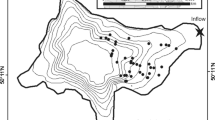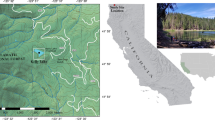Abstract
The relationship between diatom (Bacillariophyceae) taxa preserved in surface lake sediments and measured limnological and environmental variables in 22 lakes near Yellowknife (N.W.T.) was explored using multivariate statistical methods. The study sites are distributed along a latitudinal gradient that includes a strong vegetational gradient of boreal forests in the south to arctic tundra conditions in the north. Canonical correspondence analysis (CCA) revealed that lakewater concentrations of dissolved inorganic carbon (DIC) and dissolved organic carbon (DOC) each accounted for independent and statistically significant proportions of variation in the distribution of diatom taxa. Weighted-averaging (WA) models were developed to infer DIC and DOC from the relative abundances of the 76 most common diatom taxa. These models can now be used to infer past DIC and DOC concentrations from diatom assemblages preserved in sediment cores of lakes in the Yellowknife area, which may provide quantitative estimates of changes in lakewater chemistry related to past vegetational shifts at treeline.
Similar content being viewed by others
References
Anderson, D. S., R. B. Davis & F. Berge, 1986. Relationships between diatom assemblages in lake surface-sediments and limnological characteristics in southern Norway. In J. P. Smol, Battarbee, R. W., Davis, R. B. & Meriläinen, J. (eds), Diatoms and Lake Acidity. Dr W. Junk Publishers, Dordrecht: 97–113.
Birks, H. J. B., S. Juggins & J. M. Line, 1990. Lake surface-water chemistry reconstructions from palaeoecological data. In B. J. Mason (ed.), The Surface Waters Acidification Programme, Cambridge University Press, Cambridge: 301–311.
Bryson, R. A., 1966. Air masses, streamlines, and the Boreal forest. Geogr. Bull. 8: 228–269.
Camburn, K. E., J. C. Kingston & D. F. Charles, 1984–1986. Paleoecological Investigation of Recent Lake Acidification. PIRLA Diatom Iconograph, PIRLA Unpublished Report Series, report 3, Indiana University, USA.
Charles, D. F., M. W. Binford. E. T. Furlong, R. A. Hites, M. J. Mitchell, S. A. Norton, F. Oldfield, M. J. Paterson, J. P. Smol, A. J. Uutala, J. R. White, D. R. Whitehead & R. J. Wise, 1990. Paleoecological investigation of recent lake acidification in the Adirondack Mountains, N.Y. J. Paleolimnol. 3: 195–241.
Clayton, J. S. & I. B. Marshal, 1972. Soil map of Canada. In The National Atlas of Canada, MacMillan Co., Toronto.
Cwynar, L. C. & R. W. Spear, 1991. Reversion of forest to tundra in the central Yukon. Ecology 72: 202–212.
Davis, M. B. & D. B. Botkin, 1985. Sensitivity of cool-temperate forests and their fossil pollen record to rapid temperature change. Quatern. Res. 23: 327–340.
Davis, R. B., D. S. Anderson & F. Berge, 1985. Palaeolimnological evidence that lake acidification is accompanied by loss of organic matter. Nature 316: 436–438.
Dixit, S. S., J. P. Smol, J. C. Kingston & D. F. Charles, 1992. Diatoms: Powerful indicators of environmental change. Environ. Sci. Technol. 26: 22–33.
Dixit, S. S., B. F. Cumming, J. C. Kingston, J. P. Smol, H. J. B. Birks, A. J. Uutala, D. F. Charles & K. E. Camburn, 1993. Diatom assemblages from Adirondack lakes (New York, USA) and the development of inference models for retrospective environmental assessment. J. Paleolimnol. 8: 27–47.
Engstrom, D. R., 1987. Influence of vegetation and hydrology on the humus budgets of Labrador lakes. Can. J. Fish. Aquat. Sci. 44: 1306–1314.
Environment Canada, 1979. Analytical methods manual. Inland Waters Directorate, Water Quality Branch, Ottawa, Canada.
Environment Canada, 1989. Ecoclimatic regions of Canada, first approximation. Ecological Land Classification Series No. 23, Ecoregions Working Group, Ottawa.
Foged, N., 1981. Diatoms in Alaska. Bibliotheca Phycologica, Band 53, J. Cramer Verlag, Vaduz, 317 pp.
Gauch, H. G. Jr., 1982. Noise reduction by eigenvector ordinations. Ecology 63: 1643–1649.
Germain, H., 1981. Flore des diatomées.: Boubée, Paris, 444 pp.
Glew, J., 1991. Miniature gravity corer for recovering short sediment cores. J. Paleolimnol. 5: 285–287.
Hall, R. & J. P. Smol, 1992. A weighted-averaging regression and calibration model for inferring total phosphorus concentration from diatoms in British Columbia (Canada) lakes. Freshwat. Biol. 27: 417–434.
Hustedt, F., 1927–1966. Die Kieselalgen Deutschlands, Österreichs und der Schweiz. In Dr. L. Rabenhorst's Kryptogamen-Flora von Deutschland, Österreich und der Schweiz, Akademische Verlagsgesellsehaft, Leipzig, 3 Vols.
Hyvärinen, H., 1985. Holocene pollen stratigraphy of Baird Inlet, east-central Ellesmere Island, arctic Canada. Boreas 14: 19–32.
Kingston, J. C. & H. J. B. Birks, 1990. Dissolved organic carbon reconstructions from diatom assemblages in PIRLA project lakes, North America. Phil. Trans. r. Soc., Lond. B 327: 279–288.
Krammer, K. & H. Lange-Bertalot, 1986–1991. Bacillariophyceae. Süßwasserflora von Mitteleuropa, (1–4), Gustav Fischer Verlag, Stuttgart, 4 Vols.
Larsen, J. A., 1989. The northern forest border in Canada and Alaska. Ecological Studies 70, Springer Verlag, 255 pp.
Line, J. M., & H. J. B. Birks, 1990. WACALIB version 2.1 — a computer program to reconstruct environmental variables from fossil assemblages by weighted averaging. J. Paleolimnol. 3: 170–173.
MacDonald, G. M., T. W. D. Edwards, K. A. Moser, R. Pienitz & J. P. Smol, 1993. Rapid response of treeline vegetation and lakes to past climatic change. Nature 361: 243–246.
Mölder, K. & R. Tynni, 1967–1973. Über Finnlands rezente und subfossile Diatomeen. Bull. Geol. Soc. Finland, 39: 199–217, 40: 151–170, 41: 235–251, 42: 129–144, 43: 203–220, 44: 141–149, 45: 159–179.
Moser, K. A. & G. M. MacDonald, 1990. Holocene vegetation change at treeline north of Yellowknife, Northwest Territories, Canada. Quatern. Res. 34: 227–239.
Payette, S., L. Filion, A. Delwaide & C. Bégin, 1989. Reconstruction of tree-line vegetation response to long-term climate change. Nature 341: 429–432.
Pienitz, R., 1989. Regression of D'Iberville sea and paleolimnology of two lakes from southern central Ungava Bay. M.A. Thesis, Laval University, Québec (Québec), 126 pp.
Pienitz, R., J. P. Smol & D. R. S. Lean, 1993. Chemical limnology of lakes from Yellowknife to Contwoyto Lake (Northwest Territories), Canada. Int. Rev. ges. Hydrobiol. (submitted).
Servant-Vildary, S. & M. Roux, 1990. Variations de température estimées à partir du déplacement en altitude des associations de diatomées: dans une séquence holocène de la Cordillère Orientale de Bolivie. C. R. Acad. Sci. Paris 311(II): 429–436.
Smol, J. P., 1983. Paleophycology of a high arctic lake near Cape Herschel, Ellesmere Island. Can. J. Bot. 61: 2195–2204.
Smol, J. P., I. R. Walker & P. R. Leavitt, 1991. Paleolimnology and hindcasting climatic trends. Verh. int. Ver. Limnol. 24: 1240–1246.
Stevenson, A. C., H. J. B. Birks, R. J. Flower & R. W. Battarbee, 1989. Diatom-based pH reconstruction of lake acidification using canonical correspondence analysis. Ambio 18: 228–233.
Ter Braak, C. J. F., 1987. Unimodal models to relate species to environment. Agricultural Mathematics Group, Wageningen, The Netherlands.
Ter Braak, C. J. F., 1988. Partial canonical correspondence analysis. In Classification and related methods of data analysis (ed. H.H. Bock), North-Holland, Amsterdam, pp. 551–558.
Ter Braak, C. J. F., 1990. CANOCO — a FORTRAN program for CANOnical Community Ordination. Microcomputer Power, Ithaca, New York, USA (including update notes).
Ter Braak, C. J. F. & H. van Dam, 1989. Inferring pH from diatoms: A comparison of old and new calibration methods. Hydrobiologia 178: 209–223.
Tynni, R., 1975–1980. Über Finnlands rezente und subfossile Diatomeen. Geol. Surv. Finland, Bulletin 274: 1–55, 284: 1–37, 296: 1–55, 312: 1–93.
Walker, I. R., J. P. Smol, D. R. Engstrom & H. J. B. Birks, 1991. An assessment of chironomidae as quantitative indicators of past climatic change. Can. J. Fish. Aquat. Sci. 48: 975–987.
Wetzel, R. G., 1983. Limnology, 2nd edition. Saunders College Publishing, 767 pp.
Wilkinson, L., 1988. SYSTAT: The system for statistics. SYSTAT Inc., Evanston, Illinois.
Wright Jr., H. E., 1984. Sensitivity and response time of natural systems to climatic change in the late Quaternary. Quatern. Sci. Rev. 3: 91–131.
Zar, J. H., 1984. Biostatistical Analysis, 2nd edn. PrenticeHall Inc., Englewood Cliffs, N.J.
Author information
Authors and Affiliations
Rights and permissions
About this article
Cite this article
Pienitz, R., Smol, J.P. Diatom assemblages and their relationship to environmental variables in lakes from the boreal forest-tundra ecotone near Yellowknife, Northwest Territories, Canada. Hydrobiologia 269, 391–404 (1993). https://doi.org/10.1007/BF00028037
Issue Date:
DOI: https://doi.org/10.1007/BF00028037




